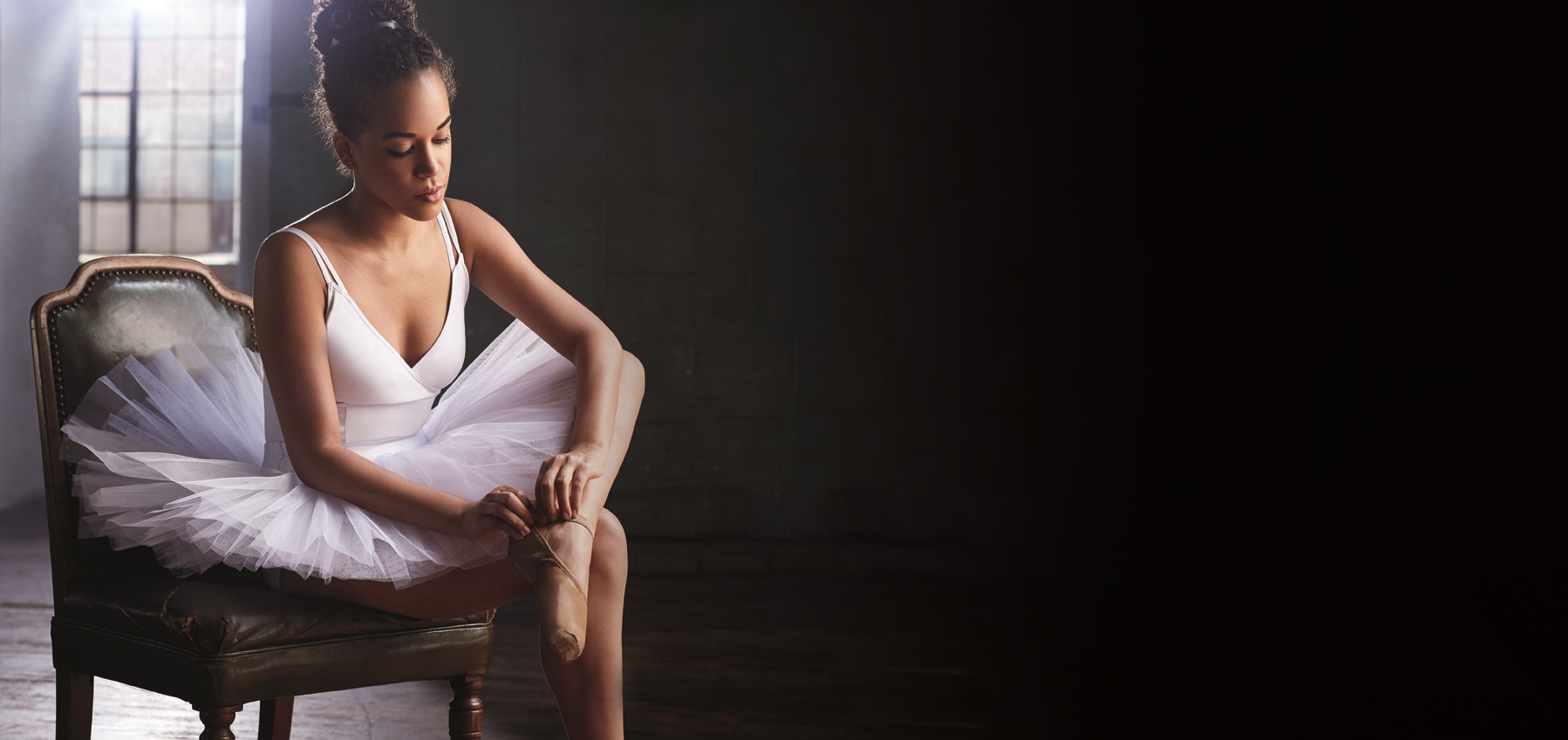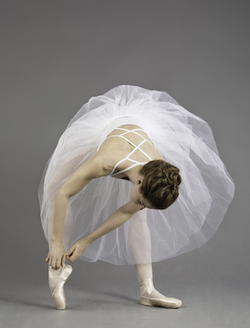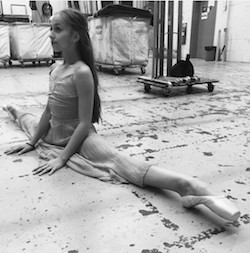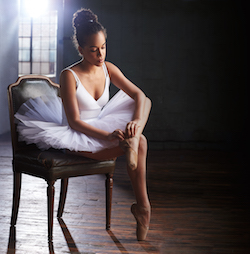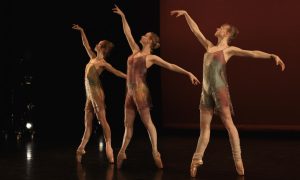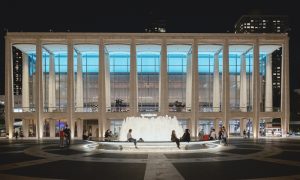Do you remember your first pointe shoe fitting and your first pointe class? Although it was uncomfortable and unconventional, it was so magical to dance on your toes. Your shoes were shiny, new and so pretty and you felt like a real ballerina.
Finding your feet in pointe is a personal journey from how you sew your ribbons and break in your shoes to what style and brand you like to wear. Some dancers seem to transition to pointe like they were made to dance on their toes and others find it a challenge of perseverance, blisters, bunions and cramping arches or aching ankles. Any ballerina will agree though, that no matter the pain, pointe is worth its ethereal illusion of weightlessness. Ballerinas are happiest when upon their toes.
Award-winning, young competition dancer and model Tate McRae, 12, started dancing at six and first started pointe about two years ago, at 10 and a half. “When I finally got en pointe, it was a dream come true,” she exclaimed. “I am finally a ballerina,” she thought.
Lauren Fadeley, stunning dancer from New York City Ballet and now Principal Dancer for Pennsylvania Ballet, started dancing at age 4 and progressed to pointe at 12. “I was sooo excited,” she said about starting pointe. “I still remember the feeling of having the pointe shoes at home but not being able to wear them until my first pointe class and waiting in suspense. I would just look at them for hours!”
Alison Stroming of Dance Theatre of Harlem felt similar excitement at 11 when she donned her first pair of pointe shoes. “It’s like opening presents on Christmas morning!” she explained. “It’s the most exciting thing in every young dancer’s life. It’s a dream for little girls to get their first pair of pointe shoes as wearing them for the first time makes you feel elegant and beautiful.”
Pointe is the epitome of elegant and beautiful and Lauren dreamed of starting pointe because she wanted to “be a real ballerina” like all the idols she had looked up to. “I had signed professional dancers’ shoes hung on my wall and I couldn’t wait to one day be like them and have my own pointe shoes,” she said. “It’s still surreal to me today to sign my old pointe shoes for little girls and picture them on their walls!”
Your first pointe fitting can be daunting as there are so many styles to choose from. Finding your perfect fit is a journey of trial and error and it can take many years, especially as your feet grow and change and the demands of your training and performance increase.
“My first pointe shoes were Suffolk,” recalled Tate. “But when I started to advance in my pointe work, I tried Capezio. I am still wearing Capezio now. I just got the new Capezio Airess,” she said.
Although dancers usually progress to different pointe shoe styles, many keep their very first pair as they hold a special place in their heart.
“My first pointe shoe was the Capezio Elan and they were a size 5,” shared Alison. “I still have them, as well as all of my other first pairs of dance shoes, in their boxes in my room! They’re all so tiny and cute and I will definitely keep them forever.”
Unlike most dancers, Alison is still wearing her first style. “Believe it or not, I am wearing the same pointe shoes as I did when I first started pointe!” she laughed. “I have tried other brands and makers of Capezios but have always gone back to my Elans.”
Lauren’s first pointe shoe was Capezio’s Contempora. As a professional, she is now wearing custom Freeds and is in talks about getting custom Capezio Arias. “I’ve worn Freeds forever, but I recently tried the Capezio Aria and Capezio Airess and really liked them. It was even requested by a choreographer that I wear the Capezios for his world premiere as he preferred them on me,” she said.
The new Capezio Airess is the latest innovation from the dancewear leader. Airess has multiple variations, with two toe shapes and three shank strengths to choose from. The shoe is designed to provide long-lasting wear and encourages maximum articulation of the foot in performance. It also has a new sock lining to envelop the foot, providing a softer feel and a gripping effect, making the pointe shoe a natural extension of the foot.
“I’ve been testing out different incarnations of the Airess for a while now,” said Lauren. “I first wore them as prototypes before they even had a name, and continue to give Capezio feedback on them. They are a beautiful new shoe and I’m so proud of Capezio for continuing to reinvent themselves and come up with new shoes based on dancers’ needs.”
“They are very strong and secure while comfortable. I love that you can actually stand in them without wobbles, as well as balance for days on the flat tip. There is also a little spring to them when you jump and they hug your feet nicely,” Lauren added.
“I feel like I could conquer the world in Airess,” exclaimed Tate. “They have so much support! And I love the look of them! They are so pretty and clean looking. They are also made with a super soft fabric inside and that makes them sooo comfy.”
As a young dancer still in training, Tate only goes through a pair of pointe shoes every six months or so. “I try to alternate two pairs at a time,” she said. “It makes them last longer and lets them dry out.”
Whereas, on the other hand, Alison and Lauren wear many, many pairs every season. “I go through one or two pairs of pointe shoes every two weeks, which is considered a small amount for a ballerina,” said Alison. “My Capezio Elans have always lasted a fairly long time because the shank in my custom shoes is much stronger than other shoes. I have very flexible ankles which is why I need a stronger shank to feel more supported,” she explained.
Lauren usually goes through two to three pairs of pointe shoes during a rehearsal week. “When I’m performing, I’ll wear a new pair for a show or two and then that’s usually it!” she exclaimed.
But no matter how many shoes you go through or what style you wear, dancing en pointe is a privilege.
“Pointe is a very special and magical thing,” said Lauren. “Not many people in the world get to get dressed up in beautiful costumes and dance on their toes for an audience. Though it can be painful, dancing en pointe really is what makes a ballerina and I can’t imagine my life without it.”
By Deborah Searle of Dance Informa.


